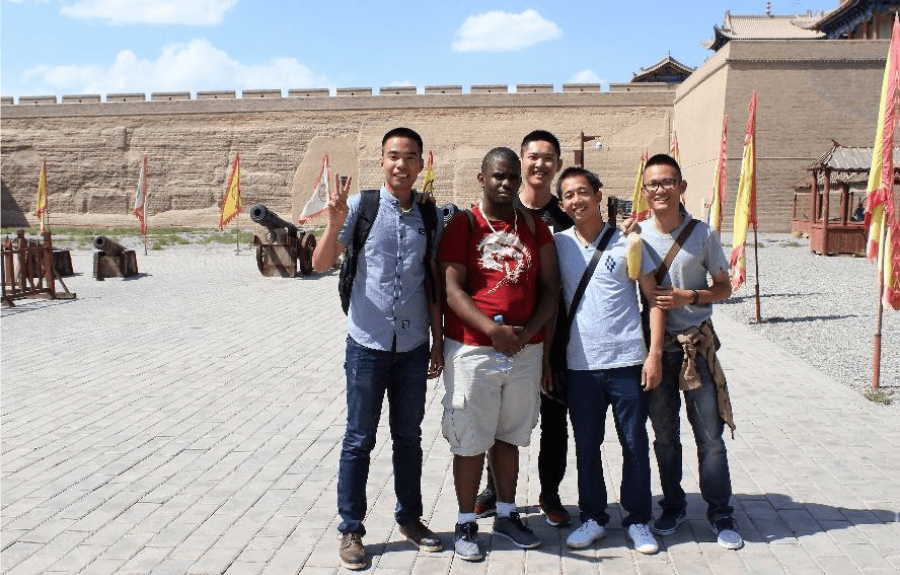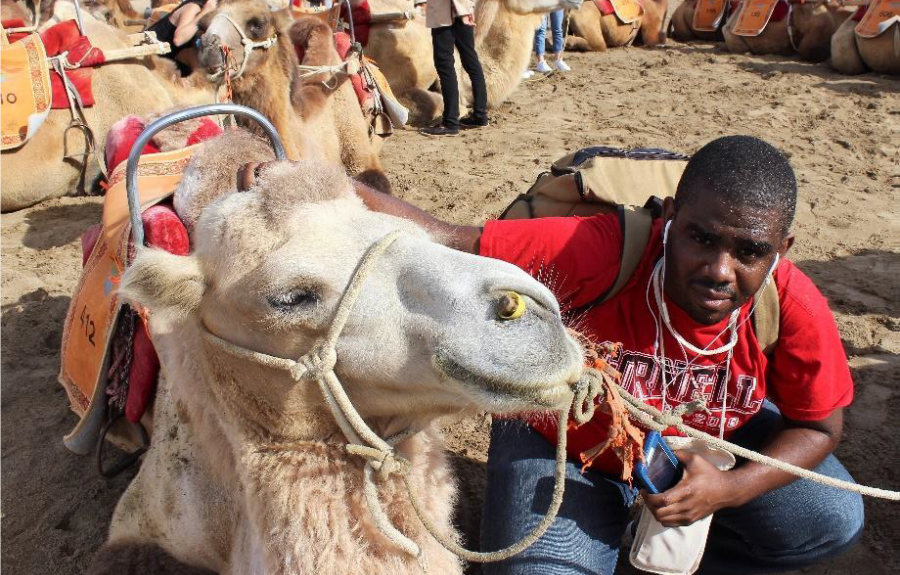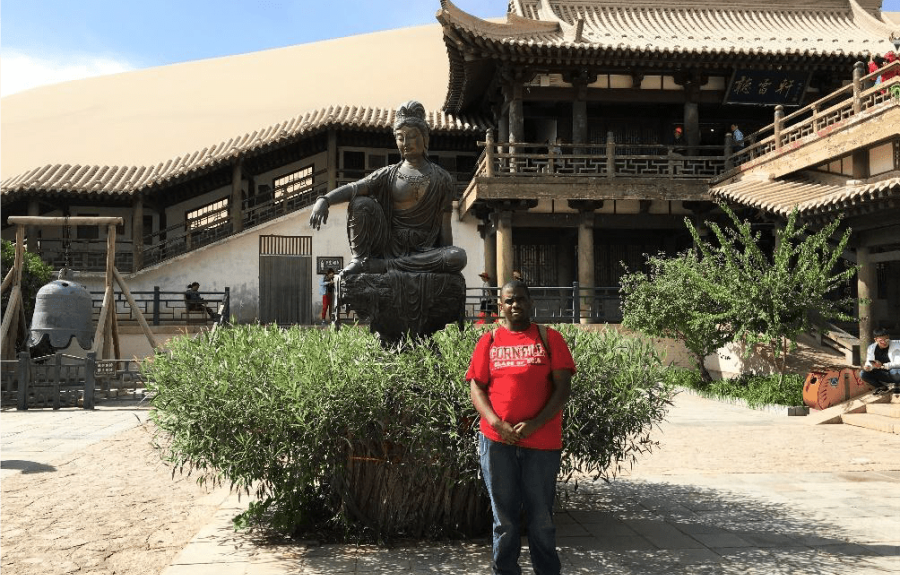Thursday, August 31st: Gansu (甘肃) This being our first night in Gansu, I didn’t really plan to go around after our food tour. Unfortunately, I wasn’t feeling that hungry because at this point I wasn’t hungry. Professor Xu Xin described this as a stomach’s jet lag, a concept that I’m leading to understanding and believe in. Cathy Hao took us for a small plate tour. In our food hopping tour, I noticed that that lamb was a key ingredient for the area, while the grilling on spears was largest cooking practice. I found the food to roughly contain three key features: meats contained both salt and spices, while vegetables had a sourness that came from either pickling or the use of vinegar. From the amount of food history that I have from the History and Cooking Channels, the favoritism of lamb is not only centered in pastoral areas; in fact cuisines from desert areas like Gansu utilize lamb meat.
Friday, September 1st: Jia Yu Guan (嘉峪关) Today we got to visit Jia Yu Guan, what I gather to be a western outpost. Understanding the tour guide today was rather difficult however, the layout of the structure was clear. This was a defensive port of entry for western Asia into China. The tour guide spoke about how Jia Yu Guan was the Ming dynasty’s section of the Great Wall. My learning highlight was finding out that we had gone through the city backwards, meaning from China into the then western wildlands. This meant the shape of the post was rested on the lower position of the hill. Entry via horse drawn carts was both slowed and made more treacherous. This fact would later be a hindered by the city’s two open squares within the walled gate. The first square allowed people to go into the market area of the port after getting past the customs officer. However, after getting past the customs office checkpoint both squares acted as bottlenecks. This system was a simple but effective way to maintain a defense. In both the squares it was made impossible to simple move forward if a group was using in form of carts or other horse drawn vehicles. Before the horse or carts could exit again they had to make a rather sharp turn on uneven stones. Professor and I talk about this was probably due to make invading forces slow down with tight squares so that they could be easily trapped and shot down by arrows.
Another fun fact our tour guide explain was that within the walls of Jia Yu Guan, there was a temple. This reflected duality within the pantheon of the time; there were different civilian gods and martial gods attributed to similar spheres abiet finance or harvest.
During our tour we went through several gates, each gate had virtues or idioms written on them, my favorite was “peace through accommodation instead of strength. Professor and Kathy and I talk about how different ruler would apply such a stamen into action and when. We discussed how this was a Confucian ideal for dealing with people before conquest, while at the same time conquering figure like Genghis Khan used this though in the craft of state building. I can see this being connected to the modern goals set of the “One belt one road system”. Though China can arguable be seen as attempting to make a conquest towards both regional and global hegemony, they are doing so through multiple bilateral style agreement; there accommodation of different states allows for great mobility. Likewise, multi bilateral agreements lessens the weight of collective action issues found in leading through multilateralism.
My favorite picture of the day was the group photos near the banner men’s weaponry. Not only did I get pictures with recent Chinese army men, I was able to see the influence of Buddhism within the military. One of the weapons with the pole arms was clearly a weighed khakkhara staff (xīzhàng, sounding staff); these staffs were originally simple tools of Buddhist monks to warn animals that they were near in order to preserve life. Later on these staff became a defensive weapon as they could trap swords or halberds within the grooves of the metal rings.
Saturday, September 2nd: Dunhuang (敦煌) A major highlight of today was us riding camels. Though fun, after sliding down a massive hill at neck breaking speed, I was not comfortable with my camel Zaggy getting too close to the edge of the sand mountains. However, on a more positive note, not only was the sights from being up on a camel great, it a totally different feeling from riding in a car, or even horseback. The mountain that we rode camel back on had to have been created over eons of years over sand blowing in the wind and being deposited.
Though the camels were fun, I found the Mogao Grottoes and Guanyin temple near the lake to be the more culturally impactful events of the day. These two events were separate as the Guanyin temples happened to be at spring very close to where we rode camels, while the Mogao Grottoes were further away.
At the lake, I found several different religious depictions of Guanyin the bodhisattva of mercy. This shows that the Gansu area had a connection with Buddhism art. This relates to the signs near our hotel, all of which had lute playing women who were dressed in close similar to the Tang imagery of Guanyin. I made a point during the trip that it common to find that temples, military bases, and cities are always near springs in desert locations. Professor Xu simply replied saying that "it is because people need to be closest to where there is water”.
Unfortunately, during our trip to the Mogao caves, where all the Buddha statues and art was, I wasn’t really able to understand the tour guide. I did catch that in cave 428 was the imagery of the story of the bodhisattva saving both man and animal through self sacrifice. The introduction movie talked about this. Likewise Cave 16 was a cave created before the 1100’s and had three depictions of Buddha and his pusa, one representing each stage of time: past { the Buddha who was}, present {the Buddha who is}, and future {the Buddha who shall be}.
Later at night our class went to an art exhibit. Like at the Mogao caves, I didn’t really understand everything that occurred. However, when Professor was talking to Kathy, he made a note that helped me understand that the imagery of the entire production. He noted that the point of the show was to say that, all of the history of this area was buried underneath sand waiting to be told. This was representing with the building being under the ground, and the heavy usage of sand. Sand was used to shower the models during the initial catwalk scene, and during the stories of the women in the 5 different rooms. Sand was removed to uncovered a story then replace to signify that the story was over.
Another key part to the event that I would catch on my own was the how Buddhism and religion played a part within the area. The main scene that represented this was the open cry of the choir, which was followed by the descent of Guanyin. Professor would later explain that a key to this scene was that red sand was meant to signify the guilty that people perceived to block Buddha’s vision of them. This guilt mostly came as as expression of the pain cause by giving valuable treasures to the hands of the west. Professor later in a side conversation with Kathy expressed a one frame of thought that Chinese had against the west; Chinese felt that when the western powers were acting out of imperialism when they, the western powers, chose not to return Chinese books that they bought in the name of protectionism.
Sunday, September 3rd: Yumen Guan (玉门关) Before reaching the Yumen Guan pass we went rock searching, though I didn’t find any clear jade, I did find some with imperfections. The key fact that that I learned from the Yumen Guan Tour was again the military strategy that came with the development of the silk road. From the position of other tower site in relation to Yu Men in order to fire signals, to the very construction of the site, I found the simply military presence of the place to be interesting. Because I couldn’t really understand our tour guide, I chose to look at the museum on my own. It was during my self lead tour that I found that the silk road, a title that I always found too western in creation, was the term of Dutch origin from an explorer and historian that came to China at the turn of the 20th century. Likewise, I felt I missed out a large portion of the Chinese history, however from what I did gather, Yumen pass was just one of triangular defense along this economic route at was associated with the great wall because both natural and pervious man made defenses had previously been overcome. Moreover, this area was recently starting to get more attention as Xi Jinping attempts to make a major preservation of national cultural heritage.
We also went on a Geo-rock park nature tour, I found it impressive that people could see animals within some of the figures shapes. I have a feeling that this land structure was the inspiration for a scene in one my favorite cartoons, Avatar the Last Airbender. In this show the character go through a great desert pass that is filled with rock formations that look like they could have been here. Moreover, this show for its geography drew heavily from the Asian world, with Qing China being represented by the fictional Earth Kingdom, whose outskirts includes deserts and mountain pass.
Overall Notes: I tried several new things from camel riding, eating donkey meat, to going to a spa with Cathy Hao. Unfortunately, there was less about the One Belt One Road System outside of the location of the highway in relation to our tour. The practical sense of the highway is that this infrastructure project will increase trade and mobilization, similar to how there was growth following the creation of the web of the American interstate highway, which connects into Canada with lower parts connecting to Mexico.
I do wish I had better grasp with my Chinese language, especially when it came to historical references. However with a lot of the places that we toured, one could feel the history to a point of understanding that crossed language barriers.








